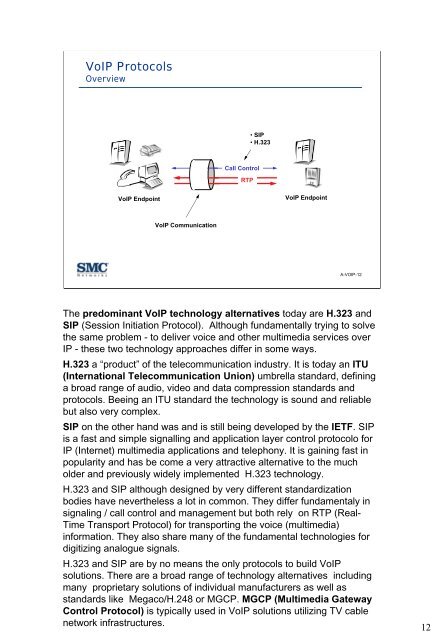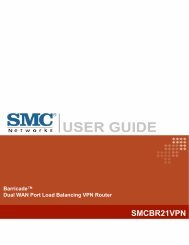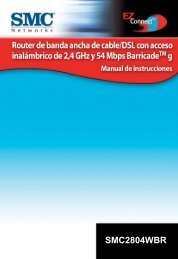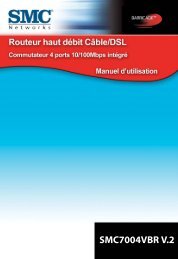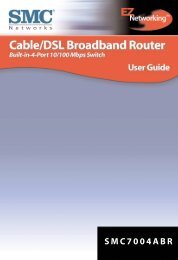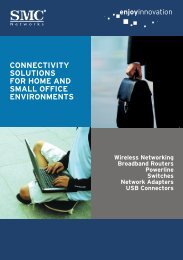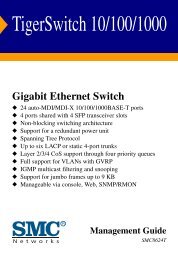Voice over IP Solutions (VoIP) - SMC
Voice over IP Solutions (VoIP) - SMC
Voice over IP Solutions (VoIP) - SMC
You also want an ePaper? Increase the reach of your titles
YUMPU automatically turns print PDFs into web optimized ePapers that Google loves.
Vo<strong>IP</strong> Protocols<br />
Overview<br />
Vo<strong>IP</strong> Endpoint<br />
Vo<strong>IP</strong> Communication<br />
Call Control<br />
RTP<br />
• S<strong>IP</strong><br />
• H.323<br />
Vo<strong>IP</strong> Endpoint<br />
A-VO<strong>IP</strong>-12<br />
The predominant Vo<strong>IP</strong> technology alternatives today are H.323 and<br />
S<strong>IP</strong> (Session Initiation Protocol). Although fundamentally trying to solve<br />
the same problem - to deliver voice and other multimedia services <strong>over</strong><br />
<strong>IP</strong> - these two technology approaches differ in some ways.<br />
H.323 a “product” of the telecommunication industry. It is today an ITU<br />
(International Telecommunication Union) umbrella standard, defining<br />
a broad range of audio, video and data compression standards and<br />
protocols. Beeing an ITU standard the technology is sound and reliable<br />
but also very complex.<br />
S<strong>IP</strong> on the other hand was and is still being developed by the IETF. S<strong>IP</strong><br />
is a fast and simple signalling and application layer control protocolo for<br />
<strong>IP</strong> (Internet) multimedia applications and telephony. It is gaining fast in<br />
popularity and has be come a very attractive alternative to the much<br />
older and previously widely implemented H.323 technology.<br />
H.323 and S<strong>IP</strong> although designed by very different standardization<br />
bodies have nevertheless a lot in common. They differ fundamentaly in<br />
signaling / call control and management but both rely on RTP (Real-<br />
Time Transport Protocol) for transporting the voice (multimedia)<br />
information. They also share many of the fundamental technologies for<br />
digitizing analogue signals.<br />
H.323 and S<strong>IP</strong> are by no means the only protocols to build Vo<strong>IP</strong><br />
solutions. There are a broad range of technology alternatives including<br />
many proprietary solutions of individual manufacturers as well as<br />
standards like Megaco/H.248 or MGCP. MGCP (Multimedia Gateway<br />
Control Protocol) is typically used in Vo<strong>IP</strong> solutions utilizing TV cable<br />
network infrastructures.<br />
12


